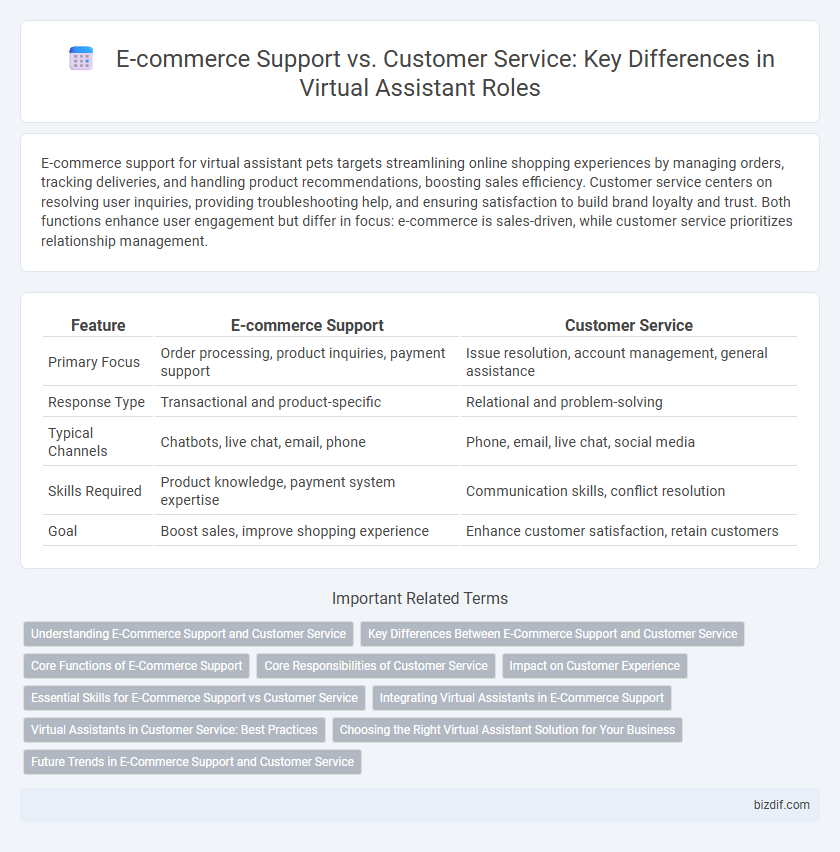E-commerce support for virtual assistant pets targets streamlining online shopping experiences by managing orders, tracking deliveries, and handling product recommendations, boosting sales efficiency. Customer service centers on resolving user inquiries, providing troubleshooting help, and ensuring satisfaction to build brand loyalty and trust. Both functions enhance user engagement but differ in focus: e-commerce is sales-driven, while customer service prioritizes relationship management.
Table of Comparison
| Feature | E-commerce Support | Customer Service |
|---|---|---|
| Primary Focus | Order processing, product inquiries, payment support | Issue resolution, account management, general assistance |
| Response Type | Transactional and product-specific | Relational and problem-solving |
| Typical Channels | Chatbots, live chat, email, phone | Phone, email, live chat, social media |
| Skills Required | Product knowledge, payment system expertise | Communication skills, conflict resolution |
| Goal | Boost sales, improve shopping experience | Enhance customer satisfaction, retain customers |
Understanding E-Commerce Support and Customer Service
E-commerce support focuses on assisting customers with online shopping experiences, including order processing, payment issues, and product inquiries, while customer service encompasses broader interactions such as handling complaints and providing post-purchase assistance. Virtual assistants specializing in e-commerce support streamline transactions and enhance user experience through real-time chat, email responses, and automated systems. Understanding the distinction improves resource allocation, allowing businesses to optimize customer satisfaction and operational efficiency within online retail environments.
Key Differences Between E-Commerce Support and Customer Service
E-commerce support specifically manages online transactions, order processing, and digital payment inquiries, ensuring seamless shopping experiences, while customer service covers a broader range of assistance including product information, returns, and general issue resolution. E-commerce support requires expertise in platform navigation, shopping cart functionality, and real-time inventory updates, distinguishing it from traditional customer service roles. Customer service emphasizes personal interaction and problem-solving across multiple channels, whereas e-commerce support focuses on optimizing digital purchasing workflows and technical assistance.
Core Functions of E-Commerce Support
E-commerce support primarily focuses on managing online transactions, assisting with product inquiries, order processing, payment verification, and handling returns or cancellations efficiently. It also involves maintaining product listings, updating inventory, and troubleshooting technical issues on the e-commerce platform to enhance user experience. Unlike general customer service, e-commerce support integrates specialized knowledge of digital sales systems, ensuring seamless operation of online storefronts and boosting overall sales performance.
Core Responsibilities of Customer Service
Customer service in e-commerce primarily involves resolving customer inquiries, processing returns and refunds, and managing complaints to ensure customer satisfaction. It also focuses on providing personalized support, guiding users through product information and order tracking. Core responsibilities emphasize maintaining a positive customer experience through timely and effective communication.
Impact on Customer Experience
E-commerce support via virtual assistants enhances customer experience by providing instant responses, personalized recommendations, and seamless order management, significantly reducing wait times and cart abandonment rates. Customer service in traditional settings often struggles with scalability and 24/7 availability, limiting swift issue resolution and overall satisfaction. Integrating virtual assistants creates a more efficient, engaging experience that drives higher retention and positive brand perception.
Essential Skills for E-Commerce Support vs Customer Service
E-commerce support requires specialized skills in managing online transactions, product inquiries, and digital payment systems, emphasizing quick resolution to enhance customer satisfaction. Customer service focuses more broadly on effective communication, empathy, and problem-solving across various channels to address diverse client needs. Both roles demand proficiency in handling customer interactions but e-commerce support prioritizes technical knowledge of online platforms and order management systems.
Integrating Virtual Assistants in E-Commerce Support
Integrating virtual assistants in e-commerce support streamlines order processing, manages inventory inquiries, and provides real-time product recommendations, enhancing the overall shopping experience. These AI-driven assistants reduce response time and operational costs compared to traditional customer service by automating routine tasks and handling high volumes of inquiries simultaneously. Leveraging natural language processing and machine learning, virtual assistants continuously improve accuracy in understanding customer intent, resulting in higher satisfaction and increased sales conversion rates.
Virtual Assistants in Customer Service: Best Practices
Virtual Assistants in customer service streamline e-commerce support by handling inquiries, processing orders, and managing returns efficiently through AI-powered chatbots and automated responses. Implementing natural language processing improves response accuracy and customer satisfaction, while continuous training on product data ensures relevant and up-to-date assistance. Emphasizing personalized interactions and multi-channel integration enhances overall customer experience and retention in e-commerce platforms.
Choosing the Right Virtual Assistant Solution for Your Business
E-commerce support virtual assistants specialize in managing product listings, processing orders, and handling inventory updates, ensuring seamless online store operations. Customer service virtual assistants focus on addressing client inquiries, resolving issues, and maintaining satisfaction through personalized communication. Choosing the right virtual assistant solution depends on prioritizing operational needs--opt for e-commerce support to streamline sales processes or customer service assistants to enhance direct client engagement.
Future Trends in E-Commerce Support and Customer Service
Future trends in e-commerce support emphasize AI-driven virtual assistants capable of personalizing customer interactions and streamlining order processing, enhancing user experience and operational efficiency. Integration of machine learning algorithms enables predictive customer service, anticipating needs and resolving issues proactively. Omnichannel support powered by virtual assistants ensures seamless communication across platforms, increasing customer satisfaction and loyalty.
E-commerce support vs Customer service Infographic

 bizdif.com
bizdif.com